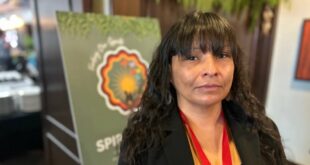Richard Neil is facing 20 charges in connection with three assaults in southern Ontario in the 1990s

'Woodland rapist' victim says genealogy helped police crack cold case
7 hours ago
A man who was attacked in a Brampton, Ont., park 30 years ago is speaking out for the first time, telling CBC News that police told him they identified the alleged 'woodland rapist' after a relative of the suspect submitted DNA to an ancestry-type website.
WARNING: This article contains graphic content and may affect those who have experienced sexual violence or know someone affected by it.
He says he was only 10 when he led skeptical investigators to the location of semen left in a Toronto-area park after he was forced to perform sex acts on a stranger.
Thirty years later, the victim says police told him DNA proved crucial in the recent arrest of an alleged serial predator. It's a key detail that authorities have not shared publicly, decades after a series of attacks set off a sprawling manhunt.
"I was shaking when I received the call" about last month's arrest, the victim told CBC News in his first public comments about the ordeal. The now-39-year-old man's identity is covered by a court-ordered publication ban. CBC News confirmed his name through court records.
"I felt overwhelmed with joy, then sadness," he said, "as I started to recall the memories of that day."
20 counts
Richard Neil, 64, was arrested in Toronto on March 3 in connection with that 1994 attack in Brampton, as well as two other assaults on children in Kitchener in 1993 and Oakville in 1995. He denies the charges.
Neil was charged with 20 counts, including kidnapping, sexual assault with a weapon and making child pornography. The allegations against him have not been proven in court.
Each of the three victims reported being lured to a wooded area, tied to a tree and assaulted. As a police task force hunted the attacker in the 1990s, the media dubbed the unidentified man the "woodland rapist."
Peel Regional Police recently said they suspect there may be more victims.
But the man who spoke to CBC News says, at first, investigators didn't believe his story.
"They accused me of making up what happened to me to get attention, not taking me seriously at all," he said in an email.
He said it was only after he indicated to investigators the precise location where the attack occurred in Brampton's Norton Place Park on Sept. 29, 1994, that their attitude began to change — if only "a little."
Police took soil samples, man says
The day after the assault, he said, he "was able to effectively lead police to the exact spot where they took several soil samples to test for DNA and found a profile" of the attacker.
That same day, Peel police issued a news release asking for the public's help in finding the man responsible. Police said the boy was walking through the park "when he was approached by the suspect and lured to a nearby wooded area where he was sexually assaulted."
Court documents show six of Neil's charges — including forcible confinement and sexual assault — are connected to the 1994 Brampton attack.
Neil's legal team has said he "has no knowledge of these crimes and maintains his innocence."
Earlier this month, the accused was granted bail, subject to conditions including that he live with family on Vancouver Island or in Toronto and that he wear an electronic monitoring device.
Neil's lawyer, Leo Adler, told CBC News at the Brampton courthouse his client is "under very strict bail conditions and the public can be assured that it's properly done."
The victim in the 1994 incident said he "couldn't believe" it when he heard his alleged attacker was being released on bail. "I was literally sick to my stomach."
Accused's relative's DNA proved key, victim says
Peel, Halton and Waterloo police, who were all involved in the investigation known as "Project Woodland," have declined to say publicly what evidence led them to Neil.
But the man who was attacked as a 10-year-old said it was ultimately the DNA of a family member of the accused that contributed to the recent development. He said he was told by a detective that a relative of Neil's had submitted their DNA to an ancestry-type website.
A former investigator on the case provided CBC News with the same account.
Police across North America have reported breakthroughs in a growing number of cases in recent years through investigative genetic genealogy. The technique involves comparing crime scene DNA to genetic data voluntarily submitted to direct-to-consumer genealogical services.
In 2020, Toronto police identified the man behind the 1984 murder of nine-year-old Christine Jessop, after the killer's distant cousin uploaded his own DNA profile to a family tree website.
After Neil's arrest, officers were seen searching his homes in both Toronto and Victoria.
Biggest breakthrough in decades-long manhunt
The charges filed last month marked the most significant development in three decades, following an on-again, off-again, multi-jurisdictional manhunt.
Investigators said in 1995 that DNA had linked all three attacks to one unknown man. For years, police failed to find a match, suggesting the perpetrator had never been arrested for a crime in which he had to submit a DNA sample.
A composite sketch of a suspect was distributed to law enforcement agencies across the province and nearby U.S. states.
Officers canvassed neighbourhoods and considered more than 1,000 persons of interest, local media later reported. Peel police examined the case again in 2009 but never made an arrest.
Although the assailant left DNA evidence at the first two crime scenes, it took a third attack for investigators to publicly connect the 1994 incident in Brampton to the 1992 assault on another young boy in similar circumstances in a Kitchener park, 65 kilometres away.
Peel police did not comment when asked last week at what point detectives started considering a link between the two attacks.
'They finally took me seriously'
After a 15-year-old girl said she'd been sexually assaulted in an Oakville park in Aug. 1995, police announced that DNA testing showed all three attacks were carried out by the same man.
"At that point," the Brampton victim told CBC News, "they finally took me seriously."
"Unfortunately someone else had to suffer … before the ball finally got rolling."
For anyone who has been sexually assaulted, there is support available through crisis lines and local support services via the Ending Violence Association of Canada database. If you're in immediate danger or fear for your safety or that of others around you, please call 911.
ABOUT THE AUTHOR
Senior Reporter
Thomas is a CBC News reporter based in Toronto. In recent years, he has covered some of the biggest stories in the world, from the 2015 Paris attacks to the Tokyo Olympics and the funeral of Queen Elizabeth II. He reported from the Lac-Mégantic rail disaster, the Freedom Convoy protest in Ottawa and the Pope's visit to Canada aimed at reconciliation with Indigenous people. Thomas can be reached at thomas.daigle@cbc.ca.
With files from Meagan Fitzpatrick
*****
Credit belongs to : www.cbc.ca
 MaharlikaNews | Canada Leading Online Filipino Newspaper Portal The No. 1 most engaged information website for Filipino – Canadian in Canada. MaharlikaNews.com received almost a quarter a million visitors in 2020.
MaharlikaNews | Canada Leading Online Filipino Newspaper Portal The No. 1 most engaged information website for Filipino – Canadian in Canada. MaharlikaNews.com received almost a quarter a million visitors in 2020.







